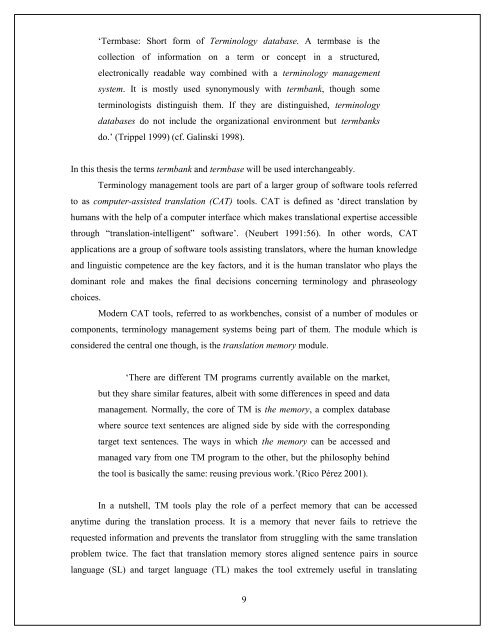systems, <strong>in</strong>formation retrieval, term databanks (TDB), computer-aided translation (CAT),mach<strong>in</strong>e translation (MT), human translation, and nomenclature (POINTER 1996).It is <strong>in</strong>structive to draw a dist<strong>in</strong>ction between the seem<strong>in</strong>gly similar discipl<strong>in</strong>es <strong>of</strong><strong>term<strong>in</strong>ology</strong> and lexicology, as well as term<strong>in</strong>ography and lexicography. While themethodology <strong>of</strong> the discipl<strong>in</strong>es <strong>in</strong> question may be <strong>in</strong> some cases similar, their focus isdifferent. Lexicology is a l<strong>in</strong>guistic specialty deal<strong>in</strong>g with general language vocabulary,while <strong>term<strong>in</strong>ology</strong> deals exclusively with special language lexis (POINTER 1996).Similarly, the general language dictionaries, compiled as a result <strong>of</strong> lexicographical work,conta<strong>in</strong> some specialist terms as part <strong>of</strong> the general vocabulary, however usually embedded<strong>in</strong> the general language entries. Term<strong>in</strong>ography <strong>in</strong> turn, deals with compil<strong>in</strong>g speciallanguage vocabulary collections solely (POINTER 1996). Another difference is manifested<strong>in</strong> the direction <strong>of</strong> work. Term<strong>in</strong>ology collection, usually restricted to a specialist doma<strong>in</strong>,beg<strong>in</strong>s with concepts, not terms themselves and proceeds with the mapp<strong>in</strong>g <strong>of</strong> the doma<strong>in</strong>with the concept delimitations i.e. terms, whereas lexicography work starts with vocabularycollection. However, there are l<strong>in</strong>guists who claim that the dist<strong>in</strong>ction between the twodiscipl<strong>in</strong>es may soon be no longer valid due to the imm<strong>in</strong>ent convergence <strong>of</strong> theirmethodologies (Campenhoudt 2001).In this thesis the author will focus on the practical aspects <strong>of</strong> <strong>term<strong>in</strong>ology</strong>, and itsapplication <strong>in</strong> mach<strong>in</strong>e-assisted human translation (MAHT), therefore only selected issuesconnected with <strong>term<strong>in</strong>ology</strong> <strong>management</strong> will be discussed.Term<strong>in</strong>ology <strong>management</strong> <strong>in</strong>volves a number <strong>of</strong> activities, rang<strong>in</strong>g from <strong>term<strong>in</strong>ology</strong>collection or extraction, to <strong>term<strong>in</strong>ology</strong> creation and validation, to classification, storage,retrieval and exchange. For the purposes <strong>of</strong> this thesis, we will focus only on the follow<strong>in</strong>gaspects <strong>of</strong> <strong>term<strong>in</strong>ology</strong> <strong>management</strong>: <strong>term<strong>in</strong>ology</strong> extraction, organization, storage, retrievaland exchange. Some aspects <strong>of</strong> validation will also be mentioned.This thesis is devoted to discuss<strong>in</strong>g <strong>term<strong>in</strong>ology</strong> <strong>management</strong> <strong>tools</strong> which are <strong>of</strong>tenreferred to as <strong>term<strong>in</strong>ology</strong> <strong>management</strong> systems (TMS). They are s<strong>of</strong>tware systems whichhelp to create and store term<strong>in</strong>ological data <strong>in</strong> the form which allows for a controlled use <strong>of</strong>the data. Term<strong>in</strong>ology <strong>management</strong> systems have nowadays become <strong>in</strong>dispensable <strong>tools</strong> fortranslation agencies and translation project managers. Thus, at least rudimentary knowledge<strong>of</strong> these systems is required <strong>of</strong> translators who seek employment with such agencies.Another central notion is that <strong>of</strong> term<strong>in</strong>ological database, or termbase:8
‘Termbase: Short form <strong>of</strong> Term<strong>in</strong>ology database. A termbase is thecollection <strong>of</strong> <strong>in</strong>formation on a term or concept <strong>in</strong> a structured,electronically readable way comb<strong>in</strong>ed with a <strong>term<strong>in</strong>ology</strong> <strong>management</strong>system. It is mostly used synonymously with termbank, though someterm<strong>in</strong>ologists dist<strong>in</strong>guish them. If they are dist<strong>in</strong>guished, <strong>term<strong>in</strong>ology</strong>databases do not <strong>in</strong>clude the organizational environment but termbanksdo.’ (Trippel 1999) (cf. Gal<strong>in</strong>ski 1998).In this thesis the terms termbank and termbase will be used <strong>in</strong>terchangeably.Term<strong>in</strong>ology <strong>management</strong> <strong>tools</strong> are part <strong>of</strong> a larger group <strong>of</strong> s<strong>of</strong>tware <strong>tools</strong> referredto as computer-assisted translation (CAT) <strong>tools</strong>. CAT is def<strong>in</strong>ed as ‘direct translation byhumans with the help <strong>of</strong> a computer <strong>in</strong>terface which makes translational expertise accessiblethrough “translation-<strong>in</strong>telligent” s<strong>of</strong>tware’. (Neubert 1991:56). In other words, CATapplications are a group <strong>of</strong> s<strong>of</strong>tware <strong>tools</strong> assist<strong>in</strong>g translators, where the human knowledgeand l<strong>in</strong>guistic competence are the key factors, and it is the human translator who plays thedom<strong>in</strong>ant role and makes the f<strong>in</strong>al decisions concern<strong>in</strong>g <strong>term<strong>in</strong>ology</strong> and phraseologychoices.Modern CAT <strong>tools</strong>, referred to as workbenches, consist <strong>of</strong> a number <strong>of</strong> modules orcomponents, <strong>term<strong>in</strong>ology</strong> <strong>management</strong> systems be<strong>in</strong>g part <strong>of</strong> them. The module which isconsidered the central one though, is the translation memory module.‘There are different TM programs currently available on the market,but they share similar features, albeit with some differences <strong>in</strong> speed and data<strong>management</strong>. Normally, the core <strong>of</strong> TM is the memory, a complex databasewhere source text sentences are aligned side by side with the correspond<strong>in</strong>gtarget text sentences. The ways <strong>in</strong> which the memory can be accessed andmanaged vary from one TM program to the other, but the philosophy beh<strong>in</strong>dthe tool is basically the same: reus<strong>in</strong>g previous work.’(Rico Pérez 2001).In a nutshell, TM <strong>tools</strong> play the role <strong>of</strong> a perfect memory that can be accessedanytime dur<strong>in</strong>g the translation process. It is a memory that never fails to retrieve therequested <strong>in</strong>formation and prevents the translator from struggl<strong>in</strong>g with the same translationproblem twice. The fact that translation memory stores aligned sentence pairs <strong>in</strong> sourcelanguage (SL) and target language (TL) makes the tool extremely useful <strong>in</strong> translat<strong>in</strong>g9


